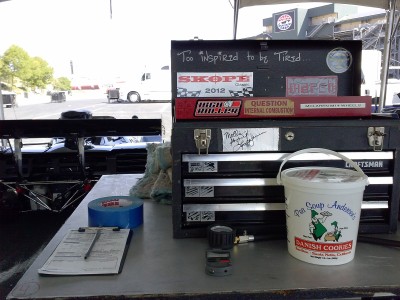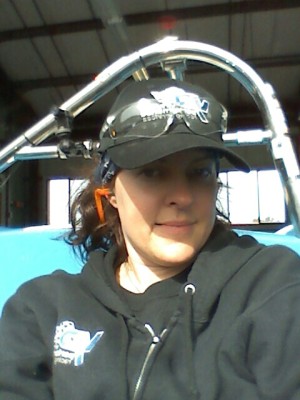The life of a vintage race car mechanic is exciting, challenging, stressful and rewarding. Most importantly, it takes the right type of person to thrive in this industry, so if you have the right demeanor, you can learn the technical skills needed and be very successful. Professional race car mechanics see vintage racing as a retirement plan and it’s great for that! But it’s also a viable career for someone who wants the excitement of racing without the extreme stress and pressure of big-business, high-stakes racing. In vintage racing, if you drop a lug nut during a pit stop, you’ll hurt your reputation and your boss’ reputation too. In professional racing, that simple mistake could be a career killer.
All the race shops I know of are organized like any small business – you go to work at 8 or 9 in the morning, you work a full 8 hour day, Monday through Friday. If the shop provides track support as well, you’ll spend some weeks away from home between March and September, particularly during June-August. If you work for a small shop, you may wear many hats, if you work for a big shop (and there aren’t too many big shops in vintage racing, but they do exist), you may have the opportunity to specialize, at least a little.
I worked for a fairly big shop and this is what it was like:
Everything was super sparkly and exciting at first. And honestly, the sparkle didn’t diminish at all during the first 3 years as I worked my way up and improved my skills. I started with basic stuff – polish the big fat racing wheels until they looked like coke mirrors, vacuum out the cockpits in between sessions, charge batteries, etc. And all this seemed awesome because the cars were like real-life comic book heroes with their bright emblematic costumes and the way they flew into action. Each car had its own distinct character – some were bright and cheerful who loved the attention of fans, others were dark and mysterious who loved to make fans jump out of their skin each time the engine roared to life.
Once I had proven myself on the small stuff, I was assigned to a vintage motorcycle to disassemble and restore. We call this a full tear-down restoration. I called it “down to the bolts” restoration because I had to polish or re-chrome each and every bolt before putting the whole jigsaw back together again. I did such a splendid job on this, that the owner purchased another identical vintage motorcycle and had me restore that one too while I started wrenching on and running the racecars.
So here’s what a day in that life was like:
In the off-season, it’s all about getting ready for the race season. This may mean bringing in new clients, repairing the cars of existing clients, replacing hard-to-find parts or having them custom fabricated from scratch if needed. We spent the winter months working on nearly the whole fleet of cars at once. Taking one engine apart until we found the culprit of an incident during the last race season, ordering a new part and then starting on another car while we waited for that part to be arrive. All day was spent disassembling engines, gearboxes, brake calipers, cooling systems, etc.; washing each individual part in a solvent tank, examining the parts for wear or damage, replacing parts as needed and reassembling the package and putting it back on the car. Some cars didn’t need repairs, but we disassembled and cleaned them anyway so we could examine each part carefully, before putting it back together and deeming it ready to race again.
So, imagine a 40 hour work week in one big room full of colorful cars in different stages of disassembling, music blaring, different mechanics working on different cars and trading places as the job called for. You have your own tools and toolbox next to your workbench. It’s a lot like the open office spaces that have become popular at tech startups these days.
Considerable time is also spent on maintaining the tools and vehicles that will be needed at the racetrack too. That’s what the motorcycles were for – moving mechanics around the paddock in a hurry and from the staging area to pit lane in time to support the car on track.
Race season is when things get exciting. And strenuous. It was a lot like working at a traveling carnival or on tour with a really loud rock band who played nothing but festivals all summer long.
In the summer, you’re on the road a LOT. You wake up in a hotel at 5 or 6 in the morning, grab a quick breakfast (usually in the breakfast area of the hotel), pile into a truck with your coworkers and caravan to the racetrack. By 7am you’re in the parking lot of the racetrack, under whatever tent your shop has provided, starting up the generator and pulling car covers off the cars as the sun tries to break through the fog. Some race groups start as early as 8am (if the track is dry enough), which means your car needs to have hot oil in the tank, a full tank of gas, fully-charged battery, accurate tire pressures, a clean/dry cockpit and every button buttoned, every latch taped down, etc.
You also need to make sure your driver is ready, which sometimes means texting him ahead of time to make sure he knows what time his/her race starts and having all his safety equipment ready to put on so he can jump in the car and go. You also better make sure you have a pit vehicle fully stocked and ready to take down to the pit lane so you are ready for anything should the driver pull in for an on-the-spot check or repair.
It’s all terribly exciting with overdoses of adrenaline all day long.
The cons are: timing your bathroom breaks because you can only pee between sessions; a growling stomach between pre-dawn breakfasts and post 1pm lunches; being out in the elements all day (pure sun blasting you in pit lane, winds whipping your face while you’re under the tent, extreme hot or extreme cold depending on the time of year and location); working through the night with halogen lights or headlights as your only illumination as needed to fix a car before its race the next morning; people watching your every move, even when you’re furiously wrenching on a hot engine 2 minutes after the car finishes a race, even when hot fluids are gushing out of some tank and you’re trying furiously to shove pans and rags under it, even when you’re lying on the hard pavement, gravel in your hair, grease on your face, under the car, trying to stop a gearbox from leaking, and oh-so-many more awkward moments…
But there are certainly personalities that will find every last minute to be pure bliss. I know I did!
Other Careers In Racing
Other careers in racing include transportation (commercial truck drivers), autobody and paint technicians, auto parts specialists, shop helpers (everything from janitorial to assisting the mechanics), administrative assistants (needed to keep track of the race schedule, book hotel rooms in fancy places for the clients/drivers and affordable accommodations for the mechanics, invoicing, payments and more), photographers, journalists, and of course, a plethora of careers at the racetrack itself – everything from the announcers to traffic control, organizers, food service and much more.
Other Careers That Utilize These Same Skills
These same skills/personality could also apply to any type of traveling mechanic, any type of tour support staff (tour manager, roadies, sound techs, etc.), traveling circuses, traveling social rights movements and more.






